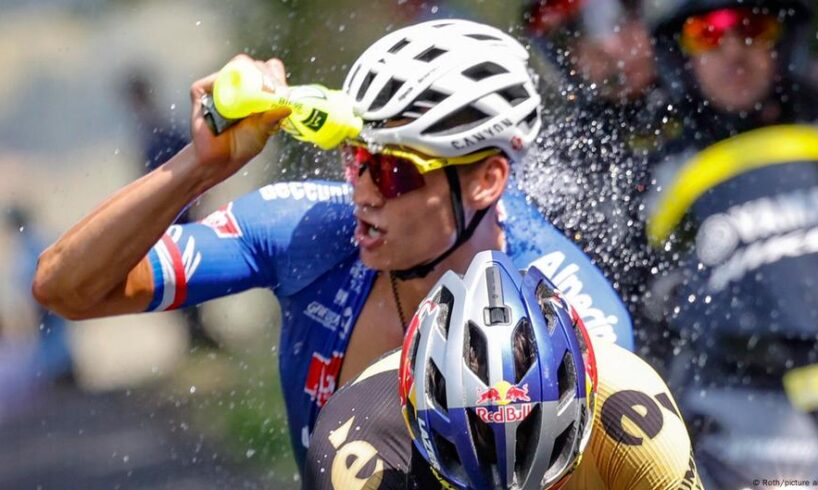
Heat training is the order of the day on the 2025 Tour de France.
Partly because the sun is shining in France and an athlete’s body should be well adapted to the heat, but also because heat training provides an extra performance boost even at more moderate temperatures.
“Active heat training was one of the main things that we changed slightly in this preparation. That was the only thing, for the rest, it was a similar preparation as the last four years,” explained Kristof de Kegel, sports scientist and Head of Performance at racing team Alpecin Deceuninck.
Mathieu van der Poel, who has already worn yellow several times on this Tour, and the recently injured Jasper Philipsen are part of that team, but the question is: Have the riders noticed the impact of heat training?
“The team in general is strong. So that’s what we think. There is no 100% link, but if we see how the team performs now and we see what we did differently from the past years, then I would say that,” de Kegel told DW.
Targeted fever for better performance
The coaches of multiple Tour de France winner Tadej Pogacar also swear by the extra kick provided by heat stimulation.
“We supplement the altitude training with heat training,” Jeroen Swart, sports scientist at UAE Emirates XRG, told DW. The aim is to raise the body’s core temperature to 38.5 degrees Celcius (101,3 degrees Fahrenheit), a slightly feverish state.
Heat training can be done passively, Austrian professional cyclist Felix Gall told DW.
“Then you go to the sauna or take a warm bath after training. With active heat training, you put on a lot of clothes during the last climb in altitude training camp or get the exercise bike.”
Legendary rider Eddy Merckx was exhausted when he reached the finish line of stage 14 in 1979. He needed oxygen support, but remarkably went on to win the Tour.Image: UPI/dpa/picture alliance
Scientific foundations
Carsten Lundby, a sports scientist from the University of Odense, Denmark, has been researching the effects of heat and altitude training and the combination of both for around 10 years.
“Heat training, in my opinion, is more effective than altitude training, when it’s done as most cycling teams do it today,” Lundby told DW.
This is mainly due to the fact that more people react to the stimuli that heat triggers in the human body than to the stress caused by thin air at altitude.
“The effects of heat training are more potent and much more widespread than altitude training,” said Lundby. “Some people don’t respond to altitude training at all. On the other hand, it’s very rare for someone not to respond to heat training. Heat is a much bigger stressor than altitude. If I had to choose between the two forms, I would always choose heat training,” Lundby said.
His studies have shown, among other things, that heat training not only increases blood volume. The greater amount of fluid can ensure that the red blood cells are better distributed in the muscle tissue, allowing more oxygen to reach them and increasing performance. The stress factor of heat also stimulates the formation of new red blood cells, which is exactly what you would expect from altitude training.
Deliberately putting the body in this stressful situation carries certain risks for health, especially for the cardiovascular system and the mind. For professional racers, who are constantly accompanied and monitored by doctors, health problems such as dehydration, loss of minerals, breathing difficulties, heatstroke, sunstroke and a sudden drop in performance are usually easy to control and can be avoided in advance.
Early adapters 33 years ago
Of course, none of this is entirely new, at least not for German champion Georg Zimmermann, who is also competing at the 2025 Tour de France.
“I’ve been a big sauna fan for years,” said Zimmermann. “It’s almost a hobby of mine. That’s why I’ve been doing it since before the topic even came up, without knowing it was training.”
Rolf Aldag, former pro cyclist and sports director at the Red Bull-Bora-hansgrohe team knows those who were early adapters.
“At the 1992 World Championships in Benidorm, Miguel Indurain arrived wearing a thermal jacket and leg warmers. That was 33 years ago.”
Back then, this was considered original. Nowadays, however, the performance managers of cycling teams integrate heat training into their routines. Heat training is also trending in other sports. Formula 1 racing teams Ferrari and Red Bull had their drivers train specifically for the heat before the 2022 Grand Prix in Singapore, and heat training is also becoming increasingly popular with marathon runners.
In cycling, heat training can have an additional positive effect. Putting on thick clothing or getting into a warm bathtub is nowhere near as expensive, costly or grueling as an altitude training camp. Teams with a smaller budget can make up ground on the leaders in the sport.
This article was originally published in German.




